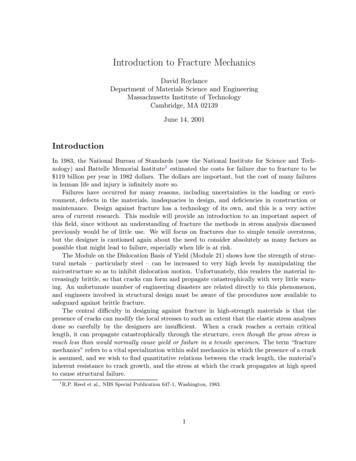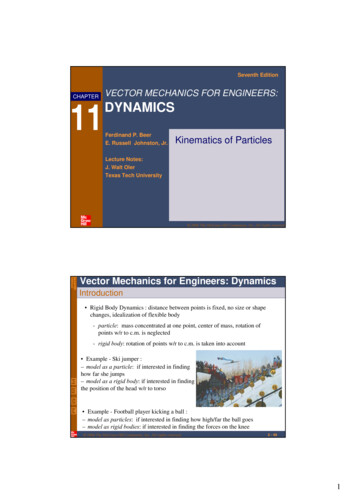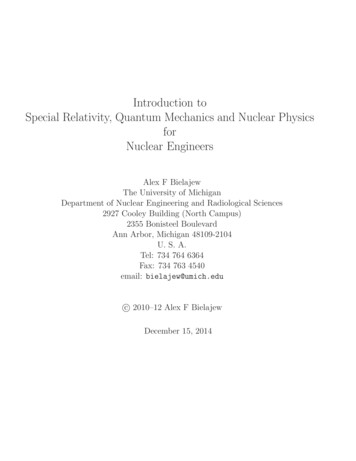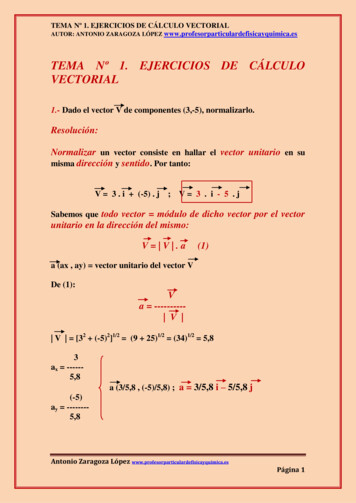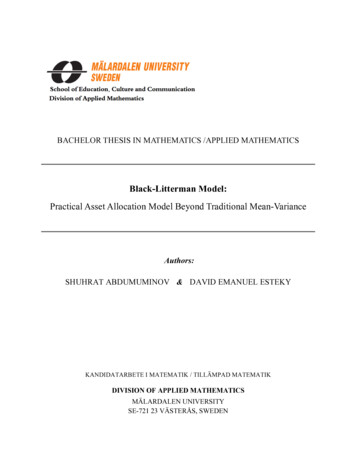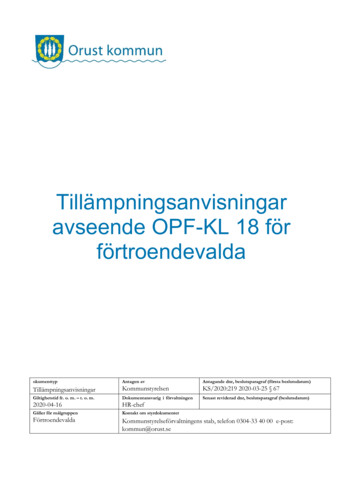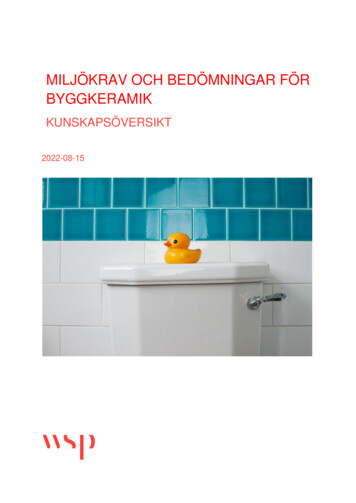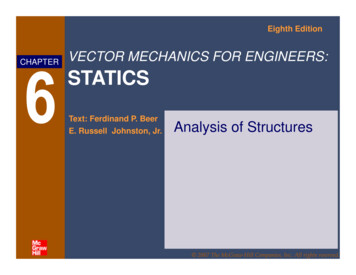
Transcription
Eighth EditionCHAPTER6VECTOR MECHANICS FOR ENGINEERS:STATICSText: Ferdinand P. BeerE. Russell Johnston, Jr.Analysis of Structures 2007 The McGraw-Hill Companies, Inc. All rights reserved.
EighthEditionVector Mechanics for Engineers: StaticsContentsIntroductionDefinition of a TrussSimple TrussesAnalysis of Trusses by the Method ofJointsJoints Under Special LoadingConditionsSpace TrussesSample Problem 6.1Analysis of Trusses by the Method ofSections 2007 The McGraw-Hill Companies, Inc. All rights reserved.Trusses Made of Several Simple TrussesSample Problem 6.3Analysis of FramesFrames Which Cease to be Rigid WhenDetached From Their SupportsSample Problem 6.4Machines6-2
EighthEditionVector Mechanics for Engineers: StaticsIntroduction For the equilibrium of structures made of severalconnected parts, the internal forces as well the externalforces are considered. In the interaction between connected parts, Newton’s 3rdLaw states that the forces of action and reactionbetween bodies in contact have the same magnitude,same line of action, and opposite sense. Three categories of engineering structures are considered:a) Frames: contain at least one one multi-forcemember, i.e., member acted upon by 3 or moreforces.b) Trusses: formed from two-force members, i.e.,straight members with end point connectionsc) Machines: structures containing moving partsdesigned to transmit and modify forces. 2007 The McGraw-Hill Companies, Inc. All rights reserved.6-3
EighthEditionVector Mechanics for Engineers: StaticsDefinition of a Truss A truss consists of straight members connected atjoints. No member is continuous through a joint. Most structures are made of several trusses joinedtogether to form a space framework. Each trusscarries those loads which act in its plane and maybe treated as a two-dimensional structure. Bolted or welded connections are assumed to bepinned together. Forces acting at the member endsreduce to a single force and no couple. Only twoforce members are considered. When forces tend to pull the member apart, it is intension. When the forces tend to compress themember, it is in compression. 2007 The McGraw-Hill Companies, Inc. All rights reserved.6-4
EighthEditionVector Mechanics for Engineers: StaticsDefinition of a TrussMembers of a truss are slender and not capable ofsupporting large lateral loads. Loads must be applied atthe joints. 2007 The McGraw-Hill Companies, Inc. All rights reserved.6-5
EighthEditionVector Mechanics for Engineers: StaticsSimple Trusses A rigid truss will not collapse underthe application of a load. A simple truss is constructed bysuccessively adding two members andone connection to the basic triangulartruss. In a simple truss, m 2n - 3 wherem is the total number of membersand n is the number of joints. 2007 The McGraw-Hill Companies, Inc. All rights reserved.6-6
EighthEditionVector Mechanics for Engineers: StaticsAnalysis of Trusses by the Method of Joints Dismember the truss and create a freebodydiagram for each member and pin. The two forces exerted on each member areequal, have the same line of action, andopposite sense. Forces exerted by a member on the pins orjoints at its ends are directed along the memberand equal and opposite. Conditions of equilibrium on the pins provide2n equations for 2n unknowns. For a simpletruss, 2n m 3. May solve for m memberforces and 3 reaction forces at the supports. Conditions for equilibrium for the entire trussprovide 3 additional equations which are notindependent of the pin equations. 2007 The McGraw-Hill Companies, Inc. All rights reserved.6-7
EighthEditionVector Mechanics for Engineers: StaticsJoints Under Special Loading Conditions Forces in opposite members intersecting intwo straight lines at a joint are equal. The forces in two opposite members areequal when a load is aligned with a thirdmember. The third member force is equalto the load (including zero load). The forces in two members connected at ajoint are equal if the members are alignedand zero otherwise. Recognition of joints under special loadingconditions simplifies a truss analysis. 2007 The McGraw-Hill Companies, Inc. All rights reserved.6-8
EighthEditionVector Mechanics for Engineers: StaticsSpace Trusses An elementary space truss consists of 6 membersconnected at 4 joints to form a tetrahedron. A simple space truss is formed and can beextended when 3 new members and 1 joint areadded at the same time. In a simple space truss, m 3n - 6 where m is thenumber of members and n is the number of joints. Conditions of equilibrium for the joints provide 3nequations. For a simple truss, 3n m 6 and theequations can be solved for m member forces and6 support reactions. Equilibrium for the entire truss provides 6additional equations which are not independent ofthe joint equations. 2007 The McGraw-Hill Companies, Inc. All rights reserved.6-9
EighthEditionVector Mechanics for Engineers: StaticsSample Problem 6.1SOLUTION: Based on a free-body diagram of theentire truss, solve the 3 equilibriumequations for the reactions at E and C. Joint A is subjected to only two unknownmember forces. Determine these from thejoint equilibrium requirements.Using the method of joints, determinethe force in each member of the truss. In succession, determine unknownmember forces at joints D, B, and E fromjoint equilibrium requirements. All member forces and support reactionsare known at joint C. However, the jointequilibrium requirements may be appliedto check the results. 2007 The McGraw-Hill Companies, Inc. All rights reserved.6 - 10
EighthEditionVector Mechanics for Engineers: StaticsSample Problem 6.1SOLUTION: Based on a free-body diagram of the entire truss,solve the 3 equilibrium equations for the reactionsat E and C. MC 0 (2000 lb )(24 ft ) (1000 lb )(12 ft ) E (6 ft )E 10,000 lb Fx 0 C xCx 0 Fy 0 2000 lb - 1000 lb 10,000 lb C yC y 7000 lb 2007 The McGraw-Hill Companies, Inc. All rights reserved.6 - 11
EighthEditionVector Mechanics for Engineers: StaticsSample Problem 6.1 Joint A is subjected to only two unknownmember forces. Determine these from thejoint equilibrium requirements.2000 lb FAB FAD 435FAB 1500 lb TFAD 2500 lb C There are now only two unknown memberforces at joint D.FDB FDAFDB 2500 lb TFDE 2 53 FDAFDE 3000 lb C() 2007 The McGraw-Hill Companies, Inc. All rights reserved.6 - 12
EighthEditionVector Mechanics for Engineers: StaticsSample Problem 6.1 There are now only two unknown memberforces at joint B. Assume both are in tension. Fy 0 1000 54 (2500) 54 FBEFBE 3750 lbFBE 3750 lb C Fx 0 FBC 1500 53 (2500) 53 (3750)FBC 5250 lbFBC 5250 lb T There is one unknown member force at jointE. Assume the member is in tension. Fx 0 53 FEC 3000 53 (3750)FEC 8750 lb 2007 The McGraw-Hill Companies, Inc. All rights reserved.FEC 8750 lb C6 - 13
EighthEditionVector Mechanics for Engineers: StaticsSample Problem 6.1 All member forces and support reactions areknown at joint C. However, the joint equilibriumrequirements may be applied to check the results. Fx 5250 53 (8750) 0 (checks) Fy 7000 54 (8750) 0 (checks) 2007 The McGraw-Hill Companies, Inc. All rights reserved.6 - 14
EighthEditionVector Mechanics for Engineers: StaticsAnalysis of Trusses by the Method of Sections When the force in only one member or theforces in a very few members are desired, themethod of sections works well. To determine the force in member BD, pass asection through the truss as shown and createa free body diagram for the left side. With only three members cut by the section,the equations for static equilibrium may beapplied to determine the unknown memberforces, including FBD. 2007 The McGraw-Hill Companies, Inc. All rights reserved.6 - 15
EighthEditionVector Mechanics for Engineers: StaticsTrusses Made of Several Simple Trusses Compound trusses are staticallydeterminant, rigid, and completelyconstrained.m 2n 3 Truss contains a redundant memberand is statically indeterminate.m 2n 3 Additional reaction forces may benecessary for a rigid truss.non-rigidm 2n 3rigidm 2n 4 2007 The McGraw-Hill Companies, Inc. All rights reserved. Necessary but insufficient conditionfor a compound truss to be staticallydeterminant, rigid, and completelyconstrained,m r 2n6 - 16
EighthEditionVector Mechanics for Engineers: StaticsSample Problem 6.3SOLUTION: Take the entire truss as a free body.Apply the conditions for static equilibrium to solve for the reactions at A and L. Pass a section through members FH,GH, and GI and take the right-handsection as a free body. Apply the conditions for staticequilibrium to determine the desiredmember forces.Determine the force in members FH,GH, and GI. 2007 The McGraw-Hill Companies, Inc. All rights reserved.6 - 17
EighthEditionVector Mechanics for Engineers: StaticsSample Problem 6.3SOLUTION: Take the entire truss as a free body.Apply the conditions for static equilibrium to solve for the reactions at A and L. M A 0 (5 m )(6 kN ) (10 m )(6 kN ) (15 m )(6 kN ) (20 m )(1 kN ) (25 m )(1 kN ) (25 m )LL 7.5 kN Fy 0 20 kN L AA 12.5 kN 2007 The McGraw-Hill Companies, Inc. All rights reserved.6 - 18
EighthEditionVector Mechanics for Engineers: StaticsSample Problem 6.3 Pass a section through members FH, GH, and GIand take the right-hand section as a free body. Apply the conditions for static equilibrium todetermine the desired member forces. MH 0(7.50 kN )(10 m ) (1 kN )(5 m ) FGI (5.33 m ) 0FGI 13.13 kNFGI 13.13 kN T 2007 The McGraw-Hill Companies, Inc. All rights reserved.6 - 19
EighthEditionVector Mechanics for Engineers: StaticsSample Problem 6.3FG 8 mα 28.07 0.5333GL 15 m MG 0(7.5 kN )(15 m ) (1 kN )(10 m ) (1 kN )(5 m )tan α ( FFH cos α )(8 m ) 0FFH 13.82 kNtan β GI5m 2 0.9375HI(8 m )3FFH 13.82 kN Cβ 43.15 ML 0(1 kN )(10 m ) (1 kN )(5 m ) (FGH cos β )(10 m ) 0FGH 1.371 kN 2007 The McGraw-Hill Companies, Inc. All rights reserved.FGH 1.371 kN C6 - 20
EighthEditionVector Mechanics for Engineers: StaticsAnalysis of Frames Frames and machines are structures with at least onemultiforce member. Frames are designed to support loadsand are usually stationary. Machines contain moving partsand are designed to transmit and modify forces. A free body diagram of the complete frame is used todetermine the external forces acting on the frame. Internal forces are determined by dismembering the frameand creating free-body diagrams for each component. Forces on two force members have known lines of actionbut unknown magnitude and sense. Forces on multiforce members have unknown magnitudeand line of action. They must be represented with twounknown components. Forces between connected components are equal, have thesame line of action, and opposite sense. 2007 The McGraw-Hill Companies, Inc. All rights reserved.6 - 21
EighthEditionVector Mechanics for Engineers: StaticsFrames Which Cease To Be Rigid When DetachedFrom Their Supports Some frames may collapse if removed fromtheir supports. Such frames can not be treatedas rigid bodies. A free-body diagram of the complete frameindicates four unknown force components whichcan not be determined from the three equilibriumconditions. The frame must be considered as two distinct, butrelated, rigid bodies. With equal and opposite reactions at the contactpoint between members, the two free-bodydiagrams indicate 6 unknown force components. Equilibrium requirements for the two rigidbodies yield 6 independent equations. 2007 The McGraw-Hill Companies, Inc. All rights reserved.6 - 22
EighthEditionVector Mechanics for Engineers: StaticsSample Problem 6.4SOLUTION: Create a free-body diagram for thecomplete frame and solve for the supportreactions. Define a free-body diagram for memberBCD. The force exerted by the link DEhas a known line of action but unknownmagnitude. It is determined by summingmoments about C.Members ACE and BCD areconnected by a pin at C and by thelink DE. For the loading shown,determine the force in link DE and thecomponents of the force exerted at Con member BCD. With the force on the link DE known, thesum of forces in the x and y directionsmay be used to find the forcecomponents at C. With member ACE as a free-body,check the solution by summingmoments about A. 2007 The McGraw-Hill Companies, Inc. All rights reserved.6 - 23
EighthEditionVector Mechanics for Engineers: StaticsSample Problem 6.4SOLUTION: Create a free-body diagram for the complete frameand solve for the support reactions. Fy 0 Ay 480 NAy 480 N M A 0 (480 N )(100 mm ) B(160 mm )B 300 N Fx 0 B AxAx 300 N Note:80 28.07 α tan 1 150 2007 The McGraw-Hill Companies, Inc. All rights reserved.6 - 24
EighthEditionVector Mechanics for Engineers: StaticsSample Problem 6.4 Define a free-body diagram for memberBCD. The force exerted by the link DE has aknown line of action but unknownmagnitude. It is determined by summingmoments about C. M C 0 (FDE sin α )(250 mm ) (300 N )(60 mm ) (480 N )(100 mm )FDE 561 NFDE 561 N C Sum of forces in the x and y directions may be used to find the forcecomponents at C. Fx 0 C x FDE cos α 300 N0 C x ( 561 N ) cos α 300 NC x 795 N Fy 0 C y FDE sin α 480 N0 C y ( 561 N ) sin α 480 NC y 216 N 2007 The McGraw-Hill Companies, Inc. All rights reserved.6 - 25
EighthEditionVector Mechanics for Engineers: StaticsSample Problem 6.4 With member ACE as a free-body, checkthe solution by summing moments about A. M A (FDE cos α )(300 mm ) (FDE sin α )(100 mm ) C x (220 mm ) ( 561cos α )(300 mm ) ( 561sin α )(100 mm ) ( 795)(220 mm ) 0(checks) 2007 The McGraw-Hill Companies, Inc. All rights reserved.6 - 26
EighthEditionVector Mechanics for Engineers: StaticsMachines Machines are structures designed to transmitand modify forces. Their main purpose is totransform input forces into output forces. Given the magnitude of P, determine themagnitude of Q. Create a free-body diagram of the completemachine, including the reaction that the wireexerts. The machine is a nonrigid structure. Useone of the components as a free-body. Taking moments about A, M A 0 aP bQ 2007 The McGraw-Hill Companies, Inc. All rights reserved.Q aPb6 - 27
Eighth Vector Mechanics for Engineers: Statics Edition 6 - 6 Simple Trusses A rigid truss will not collapse under the application of a load. A simple truss is constructed by successively adding two members and one connection to the basic triangular truss. In a simple truss, m 2 n - 3 where m is the total number of members

